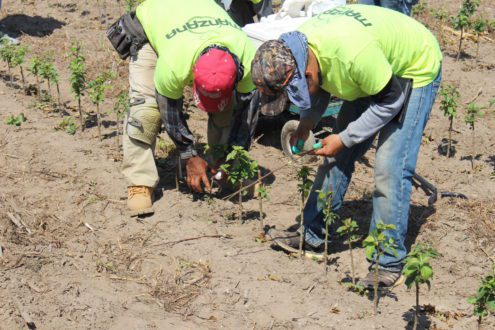
Apr 12, 2021Tree fruit rootstocks evolve over decades
This is the latest installment in a series of stories marking the 60th anniversary of Fruit Growers News.
From the heyday of Red Delicious and harvesting from ladders to today’s Honeycrisp hybrids and platform pickers, the pome fruit industry has seen a lot of change.


The late Wallace Heuser, who died in February 2019, played an important role in the introduction of dwarfing rootstocks to the U.S.
He started bringing over Malling apple rootstocks from England starting in the early 1950s, and Gisela cherry rootstocks in the 1960s, said daughter Wanda Heuser Gale. The rootstocks had been used in the U.S. before but weren’t widely accepted, and he experimented with them on the family farm and nursery in Hartford, Michigan.
“I remember looking at a Lodi (apple cultivar) on Malling 9, when I was really little, and Dad was saying, ‘Yeah, I don’t know if I’ll ever do anything with this. It just won’t stand up’ – because it was just like a little ground cover, crawling along the ground, poor thing, (with) no stake,” Heuser Gale said. “But the more he looked at these, the more he thought they had potential.”
But later on, he worked with other growers and researchers including H.B. Tukey, and was a founder and the first president of the IFTA. A pivotal first meeting in Van Buren County, Michigan attracted more attendees than expected.


“Everybody was interested in rootstocks, because they had been struggling with a seedling or something like that, you know, the same rootstock their great-grandfather grew stuff on,” Heuser Gale said. “IFTA has always been a hotbed of research about dwarfing rootstocks and growing systems to grow them with. I would definitely say IFTA is the catalyst that brought about a lot of that change.”
The industry has never stopped changing.
“We did the gamut of those Malling rootstocks,” she said. “One-eleven (m.111) was a huge, huge thing for a long time because it was very similar to seedling, which is what most apples were on at that time. It was a big, big rootstock, took several years to come into bearing. And then they thought, ‘Oh, we’ll go down to seven (m.7), because it was faster to come into bearing,’ so we went through a 15-year period where seven was the be-all and end-all. They planted millions of Red Delicious on seven out in Washington. And some of the forward-thinking guys went to 26 (m.26), thinking it was perfect because it was small, but it was precocious. … then they finally got down to Malling 9. They decided it needed support. The closer you cut it the more productive it would be per acre.
“So, that’s basically how we evolved into the systems that we’re using now. Now we’ve got all these Geneva rootstocks in, which, they’re wonderful stuff, but they’re all about that m.9 size.”
Today, Heuser Gale is president of International Plant Management, a corporation she ran with her dad that provides growers with new fruit tree selections.
“The interesting thing about this business is, very few growers are ever finished with what they’re doing,” Heuser Gale said. “Our growers are always innovative. Always.”
Finding the right rootstock
Lowell Cordas has had a lifelong fascination with fruit trees, but throughout his life in Washington and California, selecting the right rootstock has always been a big challenge for the growers he knew. He earned a degree in botany from the University of Washington in the 1970s and eventually served as director of the Saratoga Horticulture Research Foundation in California for seven years. He learned to prune trees from the University of California’s Bill Coates and remembers some of the challenges to the industry during the late 1980s and early 90s.


Later in his career, he returned to Washington where he remained interested in fruit trees as a part of amateur grower groups such as the Western Cascade Fruit Society. But rootstocks were still a baffling choice for many growers.
“What fascinated me was the lack of knowledge about rootstocks, in the groups,” he said. “Everybody wanted to be organic and environmentally conscious, very interested in preserving antique varieties. But (they had) very little knowledge of fruit nutritional needs based on where the rootstock originated and what they were trying to coax out of it in Washington state soils. We’ve got a lot of soils up here and a lot of them aren’t actually fertile. You’re growing on gravelly soil a lot of the time.”
To help educate growers, he compiled, edited and self-published a 400-page reference book, “Manual of Worldwide Temperate Zone Fruit and Nut Tree Rootstocks,” meant to help growers pick rootstocks that work well, and he’s now looking for help to continue the work cataloging different rootstocks.
“It went from the M-series (Malling rootstocks) to the B-series (Budagovsky rootstocks), and it just exploded after that,” he said. “Now they’re all excited about Geneva rootstocks. The problem is, as you go from east to west, the research indicates there’s a lot of behavioral changes in the tree based on different environmental factors.”
He hopes the development of new varieties continues at land-grant universities, knowledge is retained and growers educate themselves about the best possible rootstocks.
“We don’t have many breeders left at the university levels,” he said. “What happens when that knowledge retires?”
— Stephen Kloosterman, associate editor














